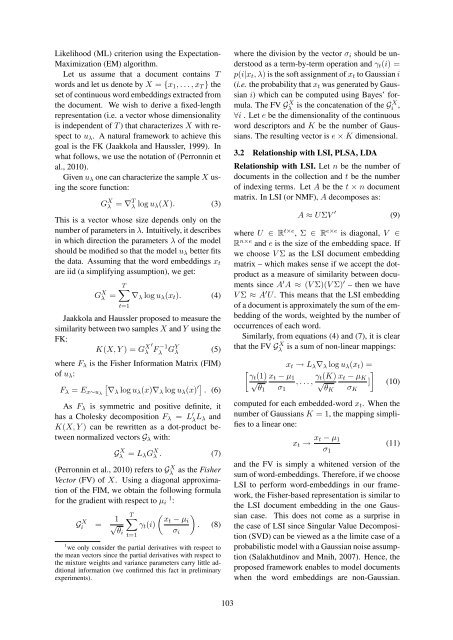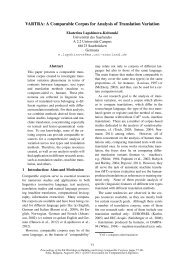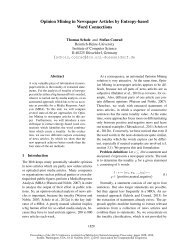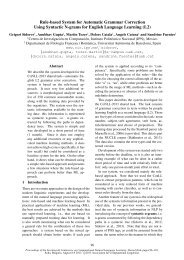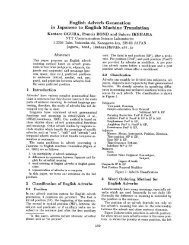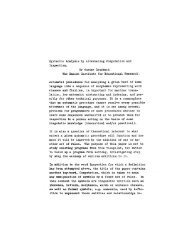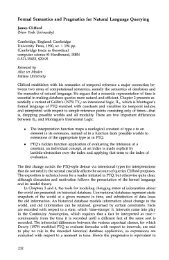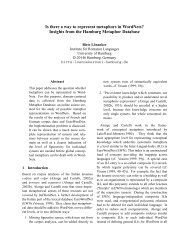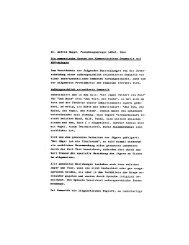Vector Space Semantic Parsing: A Framework for Compositional ...
Vector Space Semantic Parsing: A Framework for Compositional ...
Vector Space Semantic Parsing: A Framework for Compositional ...
You also want an ePaper? Increase the reach of your titles
YUMPU automatically turns print PDFs into web optimized ePapers that Google loves.
Likelihood (ML) criterion using the Expectation-<br />
Maximization (EM) algorithm.<br />
Let us assume that a document contains T<br />
words and let us denote by X = {x 1 , . . . , x T } the<br />
set of continuous word embeddings extracted from<br />
the document. We wish to derive a fixed-length<br />
representation (i.e. a vector whose dimensionality<br />
is independent of T ) that characterizes X with respect<br />
to u λ . A natural framework to achieve this<br />
goal is the FK (Jaakkola and Haussler, 1999). In<br />
what follows, we use the notation of (Perronnin et<br />
al., 2010).<br />
Given u λ one can characterize the sample X using<br />
the score function:<br />
G X λ = ∇T λ log u λ(X). (3)<br />
This is a vector whose size depends only on the<br />
number of parameters in λ. Intuitively, it describes<br />
in which direction the parameters λ of the model<br />
should be modified so that the model u λ better fits<br />
the data. Assuming that the word embeddings x t<br />
are iid (a simplifying assumption), we get:<br />
G X λ<br />
T = ∑<br />
∇ λ log u λ (x t ). (4)<br />
t=1<br />
Jaakkola and Haussler proposed to measure the<br />
similarity between two samples X and Y using the<br />
FK:<br />
K(X, Y ) = G X ′<br />
λ F<br />
−1<br />
λ GY λ (5)<br />
where F λ is the Fisher In<strong>for</strong>mation Matrix (FIM)<br />
of u λ :<br />
F λ = E x∼uλ<br />
[<br />
∇λ log u λ (x)∇ λ log u λ (x) ′] . (6)<br />
As F λ is symmetric and positive definite, it<br />
has a Cholesky decomposition F λ = L ′ λ L λ and<br />
K(X, Y ) can be rewritten as a dot-product between<br />
normalized vectors G λ with:<br />
G X λ = L λG X λ . (7)<br />
(Perronnin et al., 2010) refers to Gλ<br />
X as the Fisher<br />
<strong>Vector</strong> (FV) of X. Using a diagonal approximation<br />
of the FIM, we obtain the following <strong>for</strong>mula<br />
<strong>for</strong> the gradient with respect to µ 1 i :<br />
G X i =<br />
1<br />
√<br />
θi<br />
T ∑<br />
t=1<br />
( )<br />
xt − µ i<br />
γ t (i)<br />
. (8)<br />
σ i<br />
1 we only consider the partial derivatives with respect to<br />
the mean vectors since the partial derivatives with respect to<br />
the mixture weights and variance parameters carry little additional<br />
in<strong>for</strong>mation (we confirmed this fact in preliminary<br />
experiments).<br />
where the division by the vector σ i should be understood<br />
as a term-by-term operation and γ t (i) =<br />
p(i|x t , λ) is the soft assignment of x t to Gaussian i<br />
(i.e. the probability that x t was generated by Gaussian<br />
i) which can be computed using Bayes’ <strong>for</strong>mula.<br />
The FV G X λ is the concatenation of the GX i ,<br />
∀i . Let e be the dimensionality of the continuous<br />
word descriptors and K be the number of Gaussians.<br />
The resulting vector is e × K dimensional.<br />
3.2 Relationship with LSI, PLSA, LDA<br />
Relationship with LSI. Let n be the number of<br />
documents in the collection and t be the number<br />
of indexing terms. Let A be the t × n document<br />
matrix. In LSI (or NMF), A decomposes as:<br />
A ≈ UΣV ′ (9)<br />
where U ∈ R t×e , Σ ∈ R e×e is diagonal, V ∈<br />
R n×e and e is the size of the embedding space. If<br />
we choose V Σ as the LSI document embedding<br />
matrix – which makes sense if we accept the dotproduct<br />
as a measure of similarity between documents<br />
since A ′ A ≈ (V Σ)(V Σ) ′ – then we have<br />
V Σ ≈ A ′ U. This means that the LSI embedding<br />
of a document is approximately the sum of the embedding<br />
of the words, weighted by the number of<br />
occurrences of each word.<br />
Similarly, from equations (4) and (7), it is clear<br />
that the FV Gλ<br />
X is a sum of non-linear mappings:<br />
x t → L λ ∇ λ log u λ (x t ) =<br />
[<br />
γt (1) x<br />
√ t − µ 1<br />
, . . . , γ ]<br />
t(K) x<br />
√ t − µ K<br />
]<br />
θ1 σ 1 θK σ K<br />
(10)<br />
computed <strong>for</strong> each embedded-word x t . When the<br />
number of Gaussians K = 1, the mapping simplifies<br />
to a linear one:<br />
x t → x t − µ 1<br />
σ 1<br />
(11)<br />
and the FV is simply a whitened version of the<br />
sum of word-embeddings. There<strong>for</strong>e, if we choose<br />
LSI to per<strong>for</strong>m word-embeddings in our framework,<br />
the Fisher-based representation is similar to<br />
the LSI document embedding in the one Gaussian<br />
case. This does not come as a surprise in<br />
the case of LSI since Singular Value Decomposition<br />
(SVD) can be viewed as a the limite case of a<br />
probabilistic model with a Gaussian noise assumption<br />
(Salakhutdinov and Mnih, 2007). Hence, the<br />
proposed framework enables to model documents<br />
when the word embeddings are non-Gaussian.<br />
103


